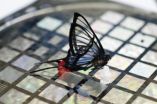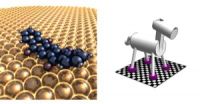(Press-News.org) A team of Welsh scientists have successfully cloned a human virus offering new hope for the treatment of potentially life-threatening diseases.
Human cytomegalovirus (HCMV) is a major infectious cause of congenital malformations worldwide. The virus is also known to cause life-threatening disease in transplant patients and people with HIV/AIDS.
The development of new treatments has been hampered as scientists have been unable to stably replicate HCMV outside the human body.
Dr Richard Stanton from Cardiff University's School of Medicine who led the joint research, said: "HCMV has by far the largest genome of all viruses affecting humans - consequently it was technically difficult to clone in an intact form in the laboratory.
"Cloning a copy of the virus from a strain isolated by Cardiff Public Health Laboratories has enabled us to identify the genes causing the instability of the virus outside the body.
"Following the identification of these genes, we have successfully developed cells in which we can grow virus that corresponds to that which exists in the human body."
Cloning the virus for the first time will help virologists develop antivirals and vaccines against the virus that causes clinical disease.
Following the study, the clone has already been distributed to research laboratories worldwide, and is being tested by the World Health Organisation (WHO) as part of a study to develop an international diagnostic standard with which to compare clinical isolates.
The genome sequence of the Cardiff virus has also been designated the international reference for HCMV in the National Centre for Biotechnology Information (NCBI) - an international database that provides reference standards for biomedical and genomic information.
Dr Stanton added: "HCMV has been designated as a highest priority vaccine target by the US Institute of Medicine. When developing vaccines, anti-viral agents and improving understanding of disease, it is crucial to work with a virus that accurately represents the virus present in patients.
"For the first time our work has enabled us to create an exact copy of the virus outside of the body offering a vital step forward in the development of new treatments."
The study, published in the The Journal of Clinical Investigationand funded by the Wellcome Trust and the Medical Research Council, was a joint collaboration between Cardiff University's Infection, Immunity and Inflammation Interdisciplinary Research Group and Drs Davison and Dargan at the Centre for Virus Research at the University of Glasgow.
The virus, named Merlin, was isolated from a clinical sample identified by the Diagnostic Unit, Public Health Wales.
INFORMATION:
Notes:
Reconstruction of the complete human cytomegalovirus genome in a BAC reveals RL13 to be a potent inhibitor of replication – is available in the on-line edition of The Journal of Clinical Investigation: www.jci.org/articles/view/42955
Further information is available by contacting:
Dr Rich Stanton
Cardiff University
School of Medicine
Tel: 029 20 687351
E-mail: StantonRJ@cf.ac.uk
School of Medicine
Cardiff University's School of Medicine is a significant contributor to healthcare in Wales, a major provider of professional staff for the National Health Service and an international centre of excellence for research, delivering substantial health benefits locally and internationally. The school's 800 staff include 500 research and academic staff who teach more than 2,000 students, including 1,110 postgraduate students.
The School is based at the Heath Park Campus, a site it shares with the University Hospital of Wales, the third largest university hospital in the UK. The School has an all-Wales role, contributing greatly to promoting, enhancing and protecting the nation's health.
A key partner in this role is the National Health Service (NHS) in Wales, with which the School is linked at all levels. This mutual dependency is illustrated by the teaching of medical undergraduates in more than 150 hospitals located in all of Wales' health authorities. The medical curriculum followed at the School enables students to acquire and apply knowledge, skills, judgement and attitudes appropriate to delivering a high standard of professional care. Around 300 new doctors currently graduate from the School every year and the Welsh Assembly Government has invested substantially in new teaching facilities to increase this number further
Cardiff University
Cardiff University is recognised in independent government assessments as one of Britain's leading teaching and research universities and is a member of the Russell Group of the UK's most research intensive universities. Among its academic staff are two Nobel Laureates, including the winner of the 2007 Nobel Prize for Medicine, Professor Sir Martin Evans.
Founded by Royal Charter in 1883, today the University combines impressive modern facilities and a dynamic approach to teaching and research. The University's breadth of expertise in research and research-led teaching encompasses: the humanities; the natural, physical, health, life and social sciences; engineering and technology; preparation for a wide range of professions; and a longstanding commitment to lifelong learning.
Beyond the orbit of Neptune reside countless icy rocks known as trans-Neptunian objects (TNOs). One of the biggest, Pluto, is classified as a dwarf planet. The region also supplies us with comets such as famous Comet Halley. Most TNOs are small and receive little sunlight, making them faint and difficult to spot.
Now, astronomers using clever techniques to cull the data archives of NASA's Hubble Space Telescope have added 14 new TNOs to the catalog. Their method promises to turn up hundreds more.
"Trans-Neptunian objects interest us because they are building blocks ...
GAINESVILLE, Fla. --- Racism may be less of a factor in politics than other realms of life, according to a new University of Florida study, which found few white voters in Florida to be upset by the presidential candidacy of a black man, and many to be proud of it.
To assess attitudes among white voters in a southern state about Barack Obama's historic election to the presidency, two UF political scientists analyzed results from four statewide telephone surveys -- each involving between 449 and 829 respondents – conducted in the fall of 2008 and spring of 2009. Their ...
Earthy or musty odors, along with visual evidence of blue-green algae, also known as cyanobacteria, may serve as a warning that harmful cyanotoxins are present in lakes or reservoirs. In a newly published USGS study of cyanobacterial blooms in Midwest lakes, taste-and-odor compounds were found almost every time cyanotoxins were found, indicating odor may serve as a warning that harmful toxins are present.
"It is commonly believed that there are no health risks associated with taste-and-odor compounds," said Dr. Jennifer Graham, USGS limnologist and lead scientist on this ...
Though it was once believed that all asteroids are giant pieces of solid rock, later hypotheses have it that some are actually a collection of small gravel-sized rocks, held together by gravity. If one of these "rubble piles" spins fast enough, it's speculated that pieces could separate from it through centrifugal force and form a second collection ― in effect, a second asteroid.
Now researchers at Tel Aviv University, in collaboration with an international group of scientists, have proved the existence of these theoretical "separated asteroid" pairs.
Ph.D. student ...
EVANSTON, Ill. --- It seems the old nature versus nurture debate can't be won. But a new Northwestern University study of men in the Philippines makes a strong case for nurture's role in male to female differences -- suggesting that rapid weight gain in the first six months of life predicts earlier puberty for boys.
Males who experienced rapid growth as babies -- an indication that they were not nutritionally stressed -- also were taller, had more muscle and were stronger, and had higher testosterone levels as young adults. They had sex for the first time at a younger ...
Gainesville, FL. -- The first genetic study to compare nuclear DNA of endangered Antillean manatees in Belize with Florida manatees confirmed their designation as separate subspecies. Belize's manatees, however, were found to have extremely low genetic diversity, raising questions about their long-term genetic viability.
The Central American country of Belize hosts the largest known breeding population of Antillean manatees and is touted by biologists for its potential to repopulate other parts of Central America where manatees are severely reduced, rare or absent.
...
When looking for a new physician, patients are often encouraged to select those who are board certified or who have not made payments on malpractice claims. Yet these characteristics are not always a good predictor of which physicians will provide the highest quality medical care, according to a new study from the RAND Corporation, a nonprofit research organization, and the University of Pittsburgh School of Medicine.
"We found that the types of information widely available to patients for choosing a physician do not predict whether that physician will deliver evidence-based ...
An unusual wildflower that accumulates metals in its leaves has been found to use them as a kind of 'armor' against bacterial infection. Scientists from Oxford University have shown that when Alpine pennycress (Thlaspi caerulescens) plants accumulate metals in their leaves, they become resistant to attack by the bacterium Pseudomonas syringae pv. maculicola. They report their findings September 9 in the open-access journal PLoS Pathogens.
Thlaspi, a small plant in the mustard family that grows on metal-rich soils scattered around Britain and Europe, such as the sites ...
VIDEO:
Artificial skin for people and robots could be a reality using the ultra-sensitive sensors developed by Zhenan Bao, associate professor of chemical engineering at Stanford University, and her team. The...
Click here for more information.
The light, tickling tread of a pesky fly landing on your face may strike most of us as one of the most aggravating of life's small annoyances. But for scientists working to develop pressure sensors for artificial skin for use on ...
RIVERSIDE, Calif. – Molecular machines can be found everywhere in nature, for example, transporting proteins through cells and aiding metabolism. To develop artificial molecular machines, scientists need to understand the rules that govern mechanics at the molecular or nanometer scale (a nanometer is a billionth of a meter).
To address this challenge, a research team at the University of California, Riverside studied a class of molecular machines that 'walk' across a flat metal surface. They considered both bipedal machines that walk on two 'legs' and quadrupedal ones ...



